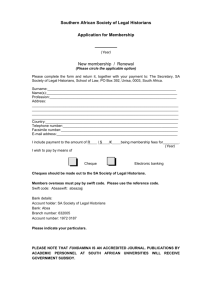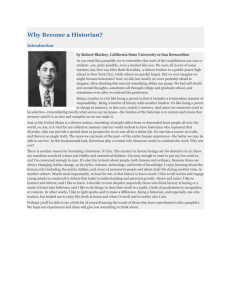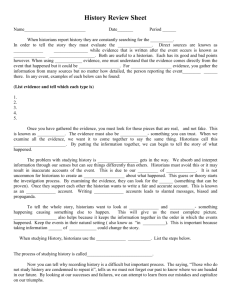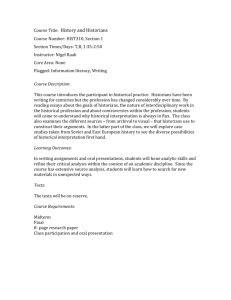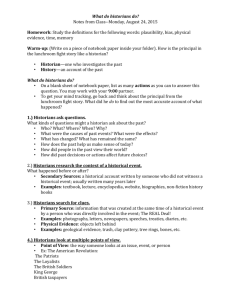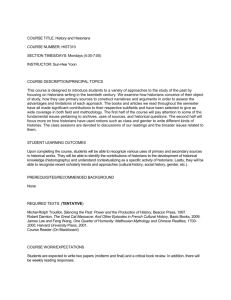Reflections on African Historians and the Teaching of African
advertisement
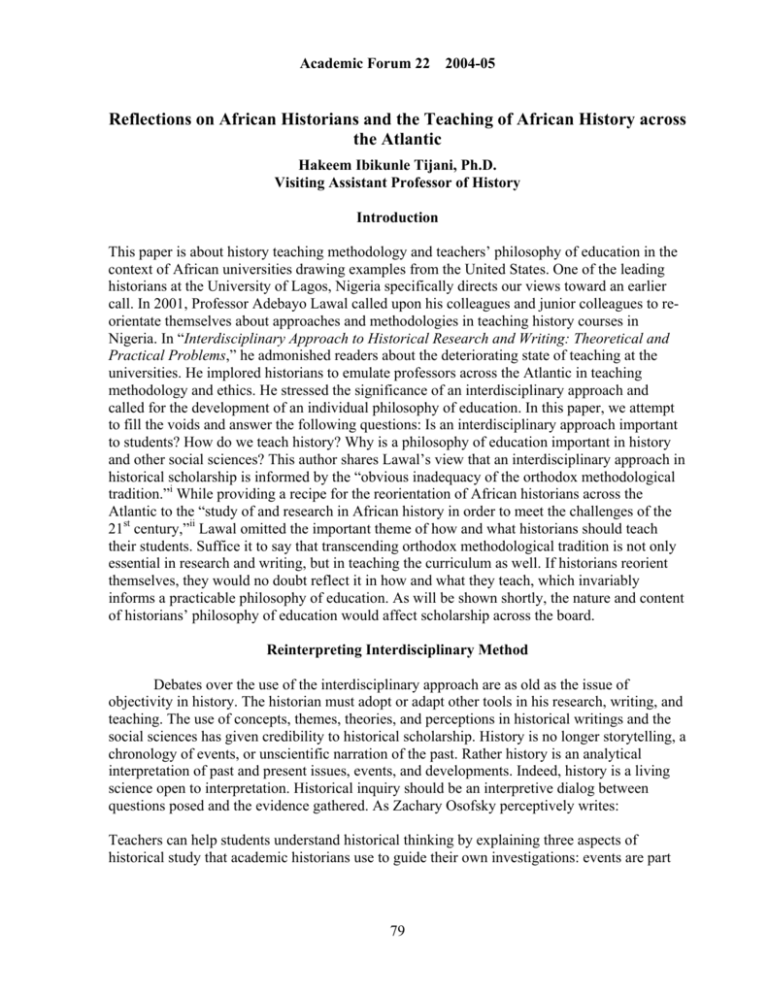
Academic Forum 22 2004-05 Reflections on African Historians and the Teaching of African History across the Atlantic Hakeem Ibikunle Tijani, Ph.D. Visiting Assistant Professor of History Introduction This paper is about history teaching methodology and teachers’ philosophy of education in the context of African universities drawing examples from the United States. One of the leading historians at the University of Lagos, Nigeria specifically directs our views toward an earlier call. In 2001, Professor Adebayo Lawal called upon his colleagues and junior colleagues to reorientate themselves about approaches and methodologies in teaching history courses in Nigeria. In “Interdisciplinary Approach to Historical Research and Writing: Theoretical and Practical Problems,” he admonished readers about the deteriorating state of teaching at the universities. He implored historians to emulate professors across the Atlantic in teaching methodology and ethics. He stressed the significance of an interdisciplinary approach and called for the development of an individual philosophy of education. In this paper, we attempt to fill the voids and answer the following questions: Is an interdisciplinary approach important to students? How do we teach history? Why is a philosophy of education important in history and other social sciences? This author shares Lawal’s view that an interdisciplinary approach in historical scholarship is informed by the “obvious inadequacy of the orthodox methodological tradition.”i While providing a recipe for the reorientation of African historians across the Atlantic to the “study of and research in African history in order to meet the challenges of the 21st century,”ii Lawal omitted the important theme of how and what historians should teach their students. Suffice it to say that transcending orthodox methodological tradition is not only essential in research and writing, but in teaching the curriculum as well. If historians reorient themselves, they would no doubt reflect it in how and what they teach, which invariably informs a practicable philosophy of education. As will be shown shortly, the nature and content of historians’ philosophy of education would affect scholarship across the board. Reinterpreting Interdisciplinary Method Debates over the use of the interdisciplinary approach are as old as the issue of objectivity in history. The historian must adopt or adapt other tools in his research, writing, and teaching. The use of concepts, themes, theories, and perceptions in historical writings and the social sciences has given credibility to historical scholarship. History is no longer storytelling, a chronology of events, or unscientific narration of the past. Rather history is an analytical interpretation of past and present issues, events, and developments. Indeed, history is a living science open to interpretation. Historical inquiry should be an interpretive dialog between questions posed and the evidence gathered. As Zachary Osofsky perceptively writes: Teachers can help students understand historical thinking by explaining three aspects of historical study that academic historians use to guide their own investigations: events are part 79 Academic Forum 22 2004-05 of a natural context, and the past is different from the present, and history is not a dispassionate catalogue of facts, but an interpretative study that relates facts to one another.iii With a better understanding of the past and present, historians, like other social scientists can prognosticate into the future. Not surprisingly, the upsurge of public history in the United States and Britain in recent years has given historians the ability to adapt concepts, themes, and theories from other fields into historical discourse. The validity of these perspectives, however, has been subjected to close scrutiny in recent time.iv It is subjective to state, therefore, that “the study of urbanization is the preoccupation of geography and sociology,” and that history is only concerned with the historical process.v Whether the historian views his topic conceptually, thematically, or theoretically, he is bound to give a comprehensive discussion and offer solutions if need be. Since not all history majors are employed as history teachers, they should be able to relate what they study to the larger society. The task of the historian is to make this happen as part of the transitional process of educating history major and minor students. Extant studies about Africa have maintained the relevance of the interdisciplinary approach with emphasis on research and writing. African society, like most societies worldwide, cannot be devoid of its economic, political, social, and legal history. Society is made up of the totality of experiences through which men and women interpret their situation, define their goals, and seek to realize them.vi It thus becomes instructive that the historian should not only make history alive in the classroom, but he must also intermesh political, economic, and social aspects in his teaching of any topic. The idea of being carried away by one school of thought or emphasizing a particular theory to the detriment of others is both subjective and biased and would only make history uninteresting to the students. Strategy for Teaching History The first thing a history instructor should do is to create a lesson plan for each section, topic, or theme to be covered during the semester. A lesson plan is an outline of what students are expected to know and the procedure adopted by the instructor in achieving the objectives. While some universities have adopted lesson plans as part of curriculum development in African universities, it is pertinent to state that efforts should be made to ensure that it is not just a window dressing exercise. A peer review and teaching observation by senior colleague should be partly based on what the instructor indicates he is going to cover in the lesson plan, and how he plans to achieve it. Therefore, model and modeling are important ingredients in any lesson plan. This implies given examples that the students would relate to in explaining issues, events, and point of view. The history teacher’s display of the interpretative nature of history through teaching would assist students in recognizing that history is not a dull subject made up of dead facts. Indicating that the past is different from the present and that society is better shaped if all understand this would help in the development of students’ cognitive process. The use of simple instructional technology such as overhead projectors, transparencies, PowerPoint presentations, and educational video- tapes is also important in teaching the syllabus. 80 Academic Forum 22 2004-05 The historian should be knowledgeable in the use of flow charts, eulogies, spoke diagrams, matrices, political cartoons, caricatures, illustrated timelines, advertisements, annotated illustrations, and mosaics. The goal is to connect history with the wider world and present both visual and non-visual explanations during class. The historian can synthesize, illustrate, recount, design, sequence, draw, and represent information, events, personalities, and issues using these teaching strategies. One should point out that the goal is to make the teaching method reflective of content and the syllabus. For instance, a PowerPoint presentation or the use of a software programme should be a tool for fostering students’ understanding rather than window dressing. The bottom-line is that “a variety of teaching methods should be presented in other to accommodate different learning styles and provide for the presentation of multiple perspectives, a critical component in the understanding of the current field of history.”vii We should state that all pedagogical presentations should be framed with student learning in mind. The current lukewarm attitudes and apathy on the part of historians to remain traditional is unacceptable if the profession is to be respected. Understanding the text used by students and historians is another aspect of teaching strategy. It is the duty of the instructor to explain the text and its usage to students. According to Judith Irvin, previewing and understanding the text are two issues in reading strategies in social studies.viii Based on his knowledge, a historian should adopt a reading strategy for his class. Previewing the text implies “identifying the purpose for reading, looking for important ideas, and connecting the reading to students’ prior knowledge.” Understanding the text on the other hand “helps students look for signal words that identify the structure of different types of texts.”ix Through various mandated workshops and conferences on teaching history or social studies in US colleges, and based on practical experience in the last five years, I have identified the following ways by which students would understand the text used for a particular course. Teaching students about these strategies has made teaching much easier and provided more time for research and publication. First, the student can use a graphic organizer that aids the understanding of cause and effect, compare and contrast, problem and solution, and sequence or chronological order. This can aid the student in presenting a tutorial topic or a seminar topic in class. Second, the use of concept maps helps students to organize main ideas and supporting details in a visual format. With this method, a student scans through and identifies a text’s headings and boldfaced terms, using that information to sketch a concept map while reading the text. The last two strategies assist the student in drawing on his prior knowledge while reading the text. The “List-Group-Label-Map” assists the student to activate his prior knowledge by making predictions. The process is first to make a list of words about the topic, categorize the words based on associations, label them, and makes a concept map about the topic. And lastly, the student may make use of “KWL” (What I know, what I want to know, what I learned) to activate prior knowledge. Prior to reading the text, the student fills out the first two columns (What I Know and What I want to Know) of a “KWL chart. The student then reads and constructs a concept map from which a summary of what is read and understood is based.x 81 Academic Forum 22 2004-05 Adapting a Philosophy of Education Writing and discussing a philosophy of education is part of an applicant’s profile in all schools in the United States. Through an applicant’s philosophy of education, a search committee would be able to determine the suitability of such candidate for the position advertised. Historians are no exception to this idea that is now a tradition in US schools. The philosophy of education adapted would be integrated into the curriculum, which forms an important part of the contract between the historian, his craft, students, and the institution. Based on experience in United States colleges and public schools, I opined that a philosophy of education should be based on an inclusive classroom, cooperative learning, and adapting technology in teaching history. Inclusion is about creating a bond between teacher and students. It is the creation of a lasting mentorship predicated on mutual respect and understanding of cultural and ethnic differences in a multicultural campus. The goal is to reach all students – students making choices in preparation for a degree. Inclusive education therefore means working with students in a context that is suitable to diverse populations. It also embraces cooperative teaching with colleagues – an interdisciplinary approach or conference teaching. Such philosophy should involve the family and community at large as part of efforts toward an enduring learning experience. Through inclusive education, students will be fully prepared for transition to a higher degree and a private or public career. They will learn the modules in history for graduation, and appreciate cooperation as part of the learning process. They will also be able to make right choices and apply historical methods to other disciplines. Through inclusion, students will maximize individual growth (which helps group development) and build a sense of community. The strategies for realizing this are based on “The Big 6 – Information Fluency” and the reflection of Bloom’s taxonomy in the lesson cycle. The Big 6 implies that history is about information – its definition, processing of information, evaluating sources, engaging and extracting information, and evaluating the information. Bloom’s taxonomy, on the other hand, signifies student knowledge, ability to analyze, critical thinking, interpretation, and reaching conclusions based on a variety of sources. The lesson circle is often the central point for teaching evaluation. The historian is expected to check for understanding by direct and indirect questions; raising issues; engaging students in debate; and challenging their knowledge and comprehension. A failure to do these is considered an academic “felony” that might debar one from gaining tenure in a United States setting. Historians (all faculties inclusive) are therefore mandated to teach with the love of their students at heart, not just dictating and rushing out of the classroom to fulfill other nonacademic goals. This is one of the recipes towards students’ mentorship in historical scholarship. Extensive use of instructional technology and the creation of a web site to assist students in further study and research should be part of teaching strategy. Students should not only be introduced to instructional technology and its use in historical/social studies education, they should also be familiarized with the adaptability of such resources in their educational 82 Academic Forum 22 2004-05 pursuit. With this in view, the prospect of a “sound synthesis and systemization of knowledge and integration of disciplines to be taught across the faculties” as proposed by Lawal is realizable.xi Conclusion The conclusion that could be drawn from the above is that the interdisciplinary approach should not be limited to historians’ writing and research but must be reflected in curriculum development, pedagogy, and classroom teaching. From time to time, historians must teach students the relevance of an interdisciplinary approach or integrate it as part of the topic being discussed. A pedagogical approach to classroom instruction gives a deeper understanding of the cognitive challenges of teaching history. This process would also aid historians’ comparative perspective on history. The ongoing attempts at some African universities in teaching history comparatively and in global context are a step in the right direction. In fact, this is what obtained in developed countries and efforts should be made to collaborate and exchange ideas with faculty in some of these institutions. Suffice it to say that students should be taught historiography and philosophy of history in a comparative and global context, drawing out the interconnectivity therein. This would invariably aid their critical thinking, systematic curiosity about a variety of subjects, and make them generalist historians upon graduation. Biography Dr. Tijani is a visiting assistant professor of history at Henderson State University, Arkadelphia, Arkansas. He has taught at the Lagos State University, Nigeria for ten years and at various public schools in the State of Texas for five years before his current position at Henderson State University. He is a recipient of the US Military National Merit Award, 2003. Endnotes i Adebayo A. Lawal, “Interdisciplinary Approach to Historical Research and Writing: Theoretical and Practical Problems,” Lagos Historical Review, volume 1, 2001: 1. ii Ibid iii Zachary Osofsky, “American History in American Classroom,” History Matters, Volume 16, Number 4, December 2003: 6. iv Hakeem Ibikunle Tijani, “Urban Politics in a Yoruba Frontier (Mushin), Nigeria,” Toyin Falola & Ann Genova (eds.) The Yoruba in Transition: History, Values and Modernity (Durham: Carolina University Press, 2005). v Lawal, “Interdisciplinary Approach”: 100. 83 Academic Forum 22 2004-05 vi Gavin Williams (ed.) Nigerian Economy and Society (London, 1976), 1-2. vii Peter Stearns et. al. (eds.) “Benchmarks for Professional Development in the Teaching of History as a Discipline,” Working Group Paper (Washington D.C.: American Historical Association, 2003), 4. viii Judith Irvin, Reading Strategies for the Social Studies Classroom (Boston: Holt, Rinehart and Winston, 2002), 98. ix Ibid. x Ibid: 100. xi Lawal, “Interdisciplinary Approach”: 101-102. 84

